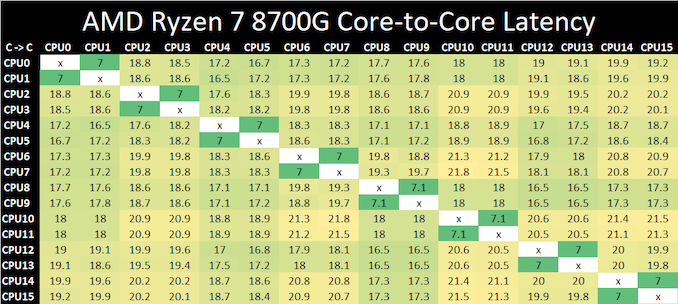AMD Ryzen 7 8700G and Ryzen 5 8600G Review: Zen 4 APUs with RDNA3 Graphics
by Gavin Bonshor on January 29, 2024 9:00 AM EST- Posted in
- CPUs
- AMD
- APUs
- Phoenix
- 4nm
- Zen 4
- RDNA3
- AM5
- Ryzen 8000G
- Ryzen 7 8700G
- Ryzen 5 8600G
Core-to-Core Latency
As the core count of modern CPUs is growing, we are reaching a time when the time to access each core from a different core is no longer a constant. Even before the advent of heterogeneous SoC designs, processors built on large rings or meshes can have different latencies to access the nearest core compared to the furthest core. This rings true especially in multi-socket server environments.
But modern CPUs, even desktop and consumer CPUs, can have variable access latency to get to another core. For example, in the first generation Threadripper CPUs, we had four chips on the package, each with 8 threads, and each with a different core-to-core latency depending on if it was on-die or off-die. This gets more complex with products like Lakefield, which has two different communication buses depending on which core is talking to which.
If you are a regular reader of AnandTech’s CPU reviews, you will recognize our Core-to-Core latency test. It’s a great way to show exactly how groups of cores are laid out on the silicon. This is a custom in-house test, and we know there are competing tests out there, but we feel ours is the most accurate to how quick an access between two cores can happen.
Looking at core-to-core latencies of the AMD Ryzen 7 8700G, as this is a monolithic Phoenix die, we can see good inter-core latencies between each of the eight individual Zen 4 cores. Going within the core, we can see solid latencies of 7ns, while things inter-core range between 17 and 21ns, showing that the Ryzen 7 8700G uses a single core cluster of eight cores.
Similar to what we've seen on previous iterations of Zen 4 and Zen 3, albeit on processors with multiple core complex (CCXs) such as the Ryzen 9 7950 and Ryzen 9 5950X, inter-core latencies are strong and low. In contrast, the Ryzen 7 8700G and other Ryzen 8000G monolithic chips on a single die remove the complications and penalties of connecting through AMD's Infinity Fabric interconnect. The Ryzen 7 8700G uses TSMC's refined 4nm manufacturing process, exactly the same as the Ryzen 7040 mobile, which is coincidentally the exact same design as the 8700G, given that AMD has repurposed Phoenix for use on AMD's AM5 desktop platform.
The core-to-core latency performance is inherently strong on the Ryzen 7 8700G, with low inter-core latencies. As expected, latency degrades a little going across the entire complex, but certainly not within the range where we would expect these penalties to cause latency issues when cores have to communicate with each other.











111 Comments
View All Comments
t.s - Tuesday, January 30, 2024 - link
well, I care.goatfajitas - Tuesday, January 30, 2024 - link
I do see your point. You can put in some high end cooling and take advantage of the speed. That still doesnt fix the fact that it runs extremely hot and power hungry compared to its competition.ricebunny - Tuesday, January 30, 2024 - link
Highly dependent on application. In games they pull around 125W, roughly the same as high end Zen 4 CPUs.goatfajitas - Tuesday, January 30, 2024 - link
"Highly dependent on application. In games they pull around 125W, roughly the same as high end Zen 4 CPUs."Agreed on some setups. I have seen some equivalently equipped SFF/Tiny desktop setups (with obviously limited thermals) and Intel drops off alot earlier. The point being it runs too hot.
WaffleTech - Sunday, February 4, 2024 - link
"roughly the same"ComputerBase measured this over more than a dozen games and on average it's 149W for the 14900K and 72W for the 7950X3D, which is less than half. Even the Non-X3D 7950X with 105W uses almost 30% less in games.
Thunder 57 - Tuesday, January 30, 2024 - link
It's the enormous heat output that is the problem, not the electric bill.yankeeDDL - Thursday, February 1, 2024 - link
"no issue"? Are you joking?Cost aside, to dissipate 400+W you need massive cooling, and the MoBo needs to be way over-designed.
Intel peaks at 4x the power of Ryzen to, maybe, marginally beat it in few benchmarks. That's not irrelevant at all: this kind of delta in efficiency applies also on mobile (albeit not so extreme): that translates in battery life (and slower performance, as on laptops you can't peak at those levels).
is4u2p - Wednesday, January 31, 2024 - link
Was this in the 12th gen mobile CPUs?lakedude - Friday, February 9, 2024 - link
"Peak power is an irrelevant metric." maybe to you.Going AMD this time allowed me to save money on the cooler and the power supply. Gonna save money on electricity as well.
I hate the way Intel plays games with their TDP these days. Don't say something is 125w TDP if it can pull over 300w. Call it a 300w chip that can be underclocked or power capped to 125w. Or have it only pull 125w out of the box rather than leave it up to the user to fiddle around with turning it down.
wwenze - Monday, February 5, 2024 - link
Well, Intel definitely has the advantage when it comes to "not dying when pushed hard" or even "not dying when running at the actual stated specs" but outdate efficiency/IPC, while AMD is the opposite on both fronts.So Intel put the pieces together and said "what if we clock it until 250W turbo TDP while the competition only has 100W at that price point"